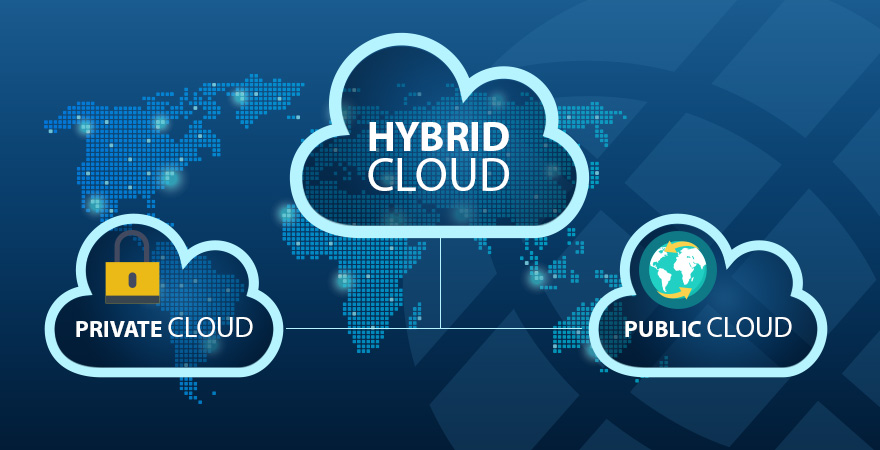Cloud Computing entails quite enticing advantages for organizations of all size and a wide array of industries. When prospecting for the cloud, the most pertinent question for any organization is which cloud architecture to adopt. Soon to follow is the logical order in which the planned transition to the cloud should be executed.

What is a Hybrid Cloud?
As the name suggests, the hallmark of any hybrid cloud solution is that some data and applications remain on premise, while the remaining are migrated over a Public Cloud Service Provider (CSP). The ratio of retention will vary in each such deployment and depend on the unique needs of each entity.
In this post, we will highlight some key factors every organization should consider before it plans a hybrid cloud computing architecture. These factors will hopefully alleviate the complexities you may face in partially migrating to the cloud.

Related Posts:
- Top 8 Hybrid Cloud Computing Expectations for 2020
- Hybrid Cloud Outlook for Year 2020
- Recap of Cloud Computing in 2019 and Outlook for 2020
Prospecting for the Hybrid Cloud
This is by far the most pivotal step in any cloud migration. Work should begin by determining the current state of an organization’s I.T hardware. It is critical to outline the limitations in the current on premise architecture, as this will act as a starting point.
Once this phase is complete, the organization must outline the specifics of how a hybrid cloud deployment will help the organization overcome its inherent challenges. It is also important to consider whether a hybrid environment aligns well with the medium to long term goals of the prospecting entity.
Factoring of Costs
An organization should not simply get carried away by the idea of cost savings we typically associate with the cloud. Firstly, a hybrid cloud surely implies that some or major part of storage and compute hardware will have to be maintained on premise.
This will entail both capital and revenue nature expenses. There are also administrative costs to maintaining hardware on premise. As your wish list of cloud based services grows, so does your monthly cloud bill. Each organization must carefully compare the costs of owning or renting IT hardware.
Also Read:
- Recap of Cloud Computing in 2019 and Outlook for 2020
- dinCloud’s Public, Colo, Private & Hybrid Offerings
- Cloud Orchestration & Management Platform by dinCloud – dinManage
- 3 Things Every Small Business Can Do With Hybrid BPM and RPA
- Why Multi Cloud Computing Is Better Than Hybrid Cloud Computing?
Business Continuity (BC) and Disaster Recovery (DR)
Typically, an organization has to invest in a dedicated DR site in the absence of a cloud solution to ensure BC. However, once you move even partially to the cloud, this need is largely mitigated because most present cloud solutions come bundled with highly robust DR and BC solutions for fraction of the cost.

One key thing to remember is that in the hybrid cloud, the need for maintaining a DR site for the on premise data and applications that haven’t been moved to the cloud will remain a necessity. The partial movement was in fact made for the sole purpose of retaining some data and apps on premise.
Staggered Approach
As migrating to the hybrid cloud is a major step for an organization, one should avoid a knee jerk approach. Data in general and workloads in particular should be shifted over the cloud environment in phases and the progress of each step should first be evaluated against the laid down benchmarks before proceeding.
Evaluation of Cloud Stack
A very enticing feature of present cloud solutions is they come bundled with most enterprise productivity software and applications. Before a full on migration, each entity must evaluate the performance of the cloud delivered application stack and also tweak its features to fully align them with organizational goals.
Outsourcing Heavy Workloads
This process will be crucial for the overall success of migrating to the cloud. To fully avail the capability of cloud architecture in terms of handling processing intensive tasks, an entity should migrate less sensitive workloads to the cloud based solution. This will bring about efficiency and reduce the burden on in house hardware.
Licensing Costs
This will be an important aspect of the hybrid cloud in terms of both costs and compliance. As most CSPs have sound arrangements with software and application providers, it is quite possible that the licensing benefits may trickle down at fractional or no additional cost to the extent of on premise deployments.
Even otherwise, licensed software and apps tend to behave more stably and are also regularly patched for plugging any bugs or vulnerabilities. This in turn will improve organizational efficiency and also improve the end user experience in a notable way.
Regulation and Compliance
This is a highly sensitive aspect of executing a hybrid cloud transition. Firstly, an organization may be incapacitated to shift some data over the cloud due its sensitivity. Even otherwise, the regulatory compliance of a CSP with the applicable regulations should be a key consideration before any data can be shifted over the cloud.
Workload Allocation
Any hybrid cloud solution is way more complex as compared to a full on premise or cloud architecture. A very crucial aspect of this migration will be how the organizational workloads are allocated across the on premise and cloud powered infrastructures.
Automation of Workloads
To achieve the expected results from the hybrid cloud, the most efficient and effective way is to automate the allocation of workloads across the two environments. This will initially increase the complexity of the solution but in the mid to long term, this approach is highly likely to pay dividends.
Integration of Applications
The main end goal behind any cloud migration is to improve organizational efficiency. This will be achieved only if the existing data of an organization integrates with the new cloud based software platforms, which are scheduled to take on the workloads once the migration has taken full effect
Also Read:
- UAE at the Brink of a Major Cloud Revolution [2020]
- Top 10 Cloud Computing Trends and Outlook for 2020
- 8 Reasons: Why Cloud Computing For Small Business?
Conclusion
A hybrid cloud architecture is both complex and ambitious. An organization must have very tangible reasons for opting in favor of the hybrid cloud model. Perhaps the most critical factor in this entire process is how well the partial migration to the cloud is planned and subsequently executed.
Lastly, each organization prospecting for the cloud must understand that as the complexity and scale of a cloud based service increases, the costs also tend to rise exponentially. It is never a very good position where an organization ends up paying higher cloud usage bills than cost of owning the hardware.


